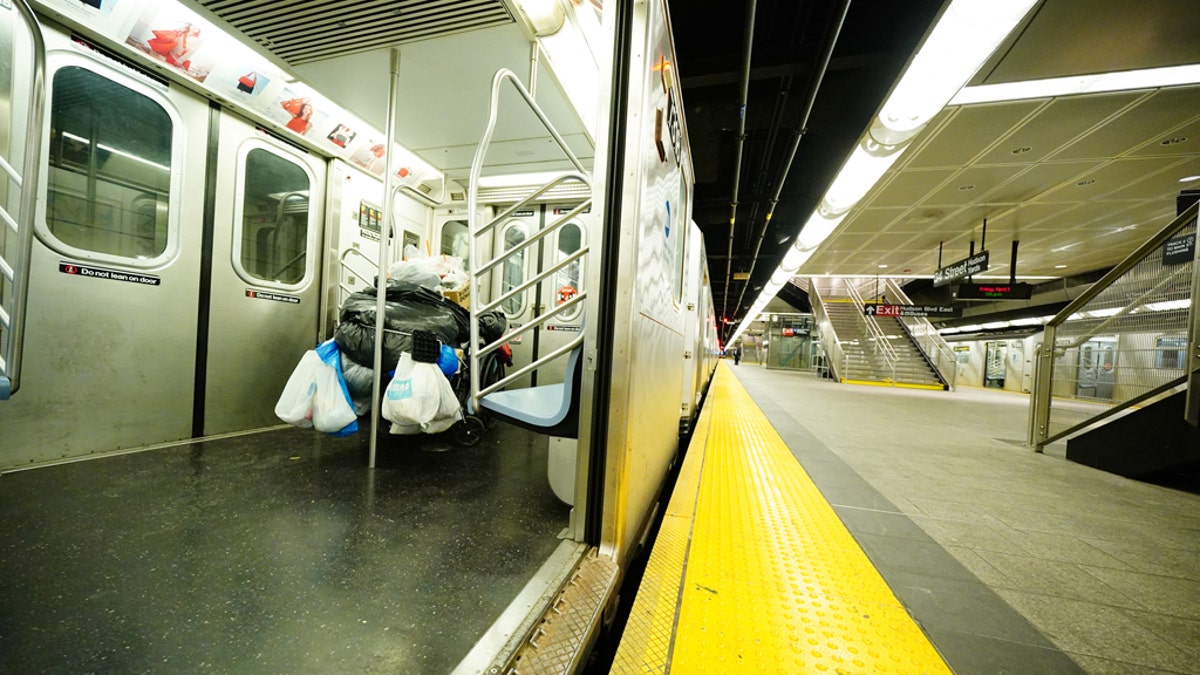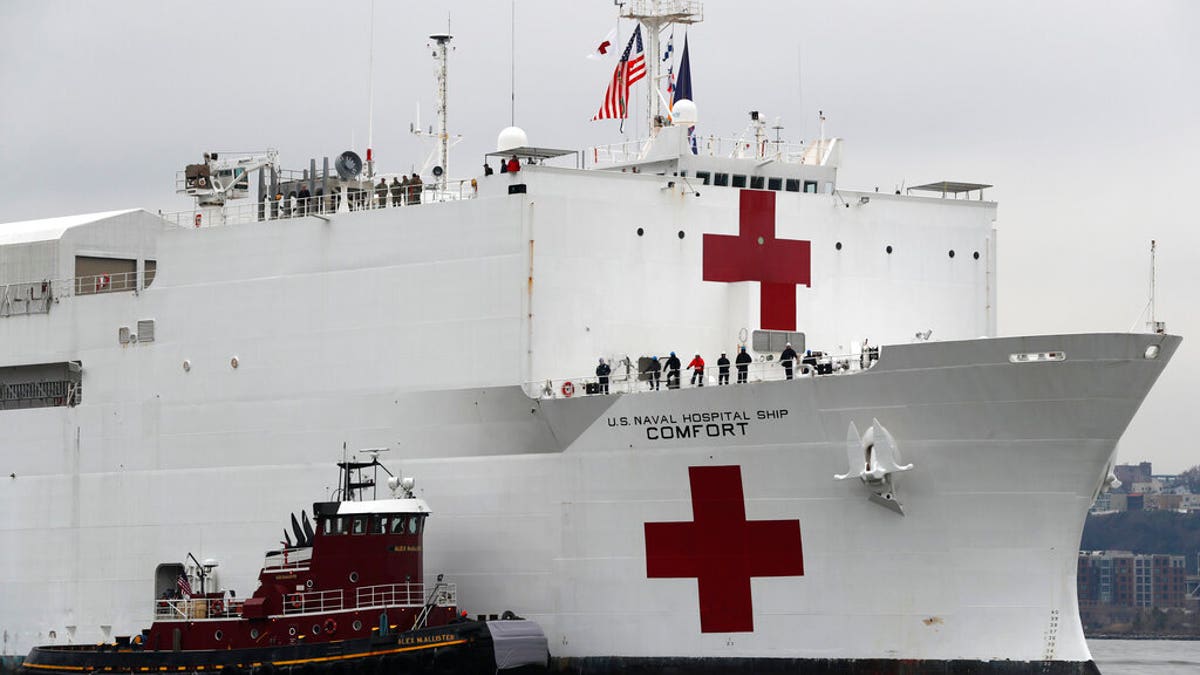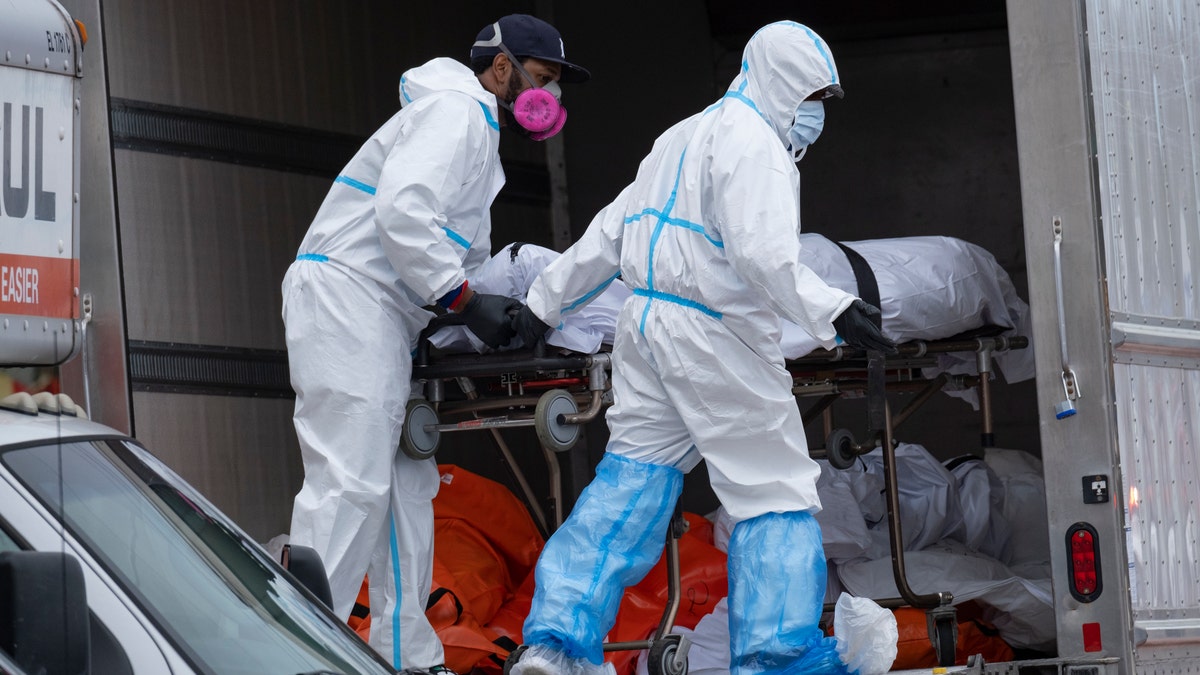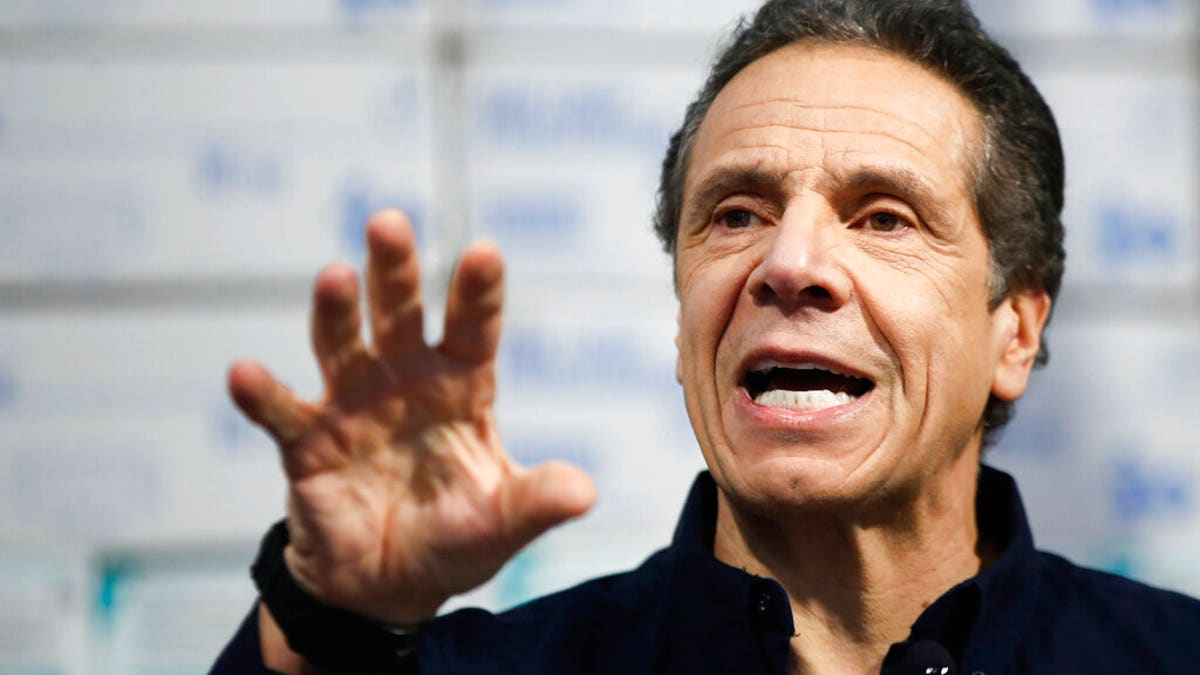Cuomo remains resistant to reopening New York, considers extending restrictions in some parts of the state
Reaction from New York Republican Rep. Tom Reed.
Get all the latest news on coronavirus and more delivered daily to your inbox. Sign up here.
While New York has weathered the brunt of coronavirus infections and deaths, the state’s apparent hoarding of medical supplies, and the millions spent on equipment that never arrived, as well as unused hospitals and beds, have some questioning what went wrong.
Early to mid-March projections of the spread of COVID-19 had the state scrambling to bolster its hospital bed capacity to more than double its 53,000 maximum status-quo. Subsequently, hospitals statewide were ordered to discharge patients to free up beds, and forced to add new ones as non-emergency procedures were canceled.
CLICK HERE FOR COMPLETE CORONAVIRUS COVERAGE

A homeless person takes shelter in a subway train AT Hudson Yards, New York City during a rainy afternoon amid COVID-19 pandemic on April 3, 2020. (Photo by John Nacion/NurPhoto via Getty Images)
In addition to a bevy of state orders, Gov. Andrew Cuomo made desperate overtures to the federal government to step in. In response, and in record time, the U.S. Army Corps of Engineers scrambled to erect at least four field hospitals, and the Navy deployed its USNS Comfort hospital ship to Manhattan.
However, those efforts – and the many millions of dollars spent on them – have largely been deemed a waste, even as New York has battled a soaring a death toll and is maintaining stay-at-home orders. So what happened?
"[The models] have been extremely inaccurate," Dr. David Samadi, a New York-based surgeon, told Fox News. "These models gave a horrifying prediction that suggested COVID-19 could kill anywhere from 200,000 to 1.7 million Americans. Currently, it looks to be more like 60,000 to 65,000 deaths. While any American life lost to this virus is a shame, the death and infection rate is looking not quite so bleak as it was in the beginning."
UN WARNS CORONAVIRUS FALLOUT WILL LEAD TO THE NEXT PANDEMIC – GLOBAL STARVATION
The Federal Emergency Management Agency (FEMA) is in the process of shuttering the much-touted, 2,500-bed Javits Center – having treated only around 1,000 patients over the course of more than a month – The Associated Press reported.
On Thursday, the heralded Navy ship – which was equipped with 1,000 beds and intended to take the burden off other hospitals and treat non-coronavirus patients before finally taking on a handful of those with the infection – sailed away, barely used.
The three additional field hospitals Albany spent many millions on erecting in late March are yet to close, despite treating few, and are standing idle in case there is a second wave of the disease.
The process has led to frustration for hospital officials tasked with hurriedly boosting bed counts and equipping these new facilities, yet have watched as city hospitals endured overcrowding of coronavirus patients while their own ready-to-go medical centers have sat mostly empty, at the taxpayer's expense.
For one, construction firms earned $136 million to quickly erect the Stony Brook field hospital – paid for from the Army Corps of Engineers budget. The original contract with Manhattan-based Turner Construction Co., as noted by Newsday, was initially for an amount not to exceed $101 million – yet "the number was increased on April 8 to an amount not to exceed $136 million once it became clear that more money was needed," even with the lack of patients. Still, it has hardly been used, officials said.

In this March 30, 2020 file photo, the U.S. Navy hospital ship USNS Comfort is escorted up the Hudson River on its way to New York City. On Tuesday, April 21, 2020, while expressing confidence that stresses on New York City's hospital system are easing, New York Gov. Andrew Cuomo said that the ship deployed to New York City to help fight the coronavirus outbreak is no longer needed. (AP)
Another $116.5 million was spent to spring to life a field facility on the Old Westbury campus, complete with top-notch features including hospital-grade welded linoleum floors, multiple layers of insulation, electricity, telephone infrastructure, plumbing, Wi-Fi, showers, bathrooms, and staff common areas.
Meanwhile, nursing home managers have been left bewildered as to why the empty facilities were not made available for ill and suspect coronavirus patients, who were not able to be aptly isolated from others deemed vulnerable to severe infection or death.
In April, coronavirus patients at a Brooklyn nursing home were denied admission to both of the medical facilities established in New York to handle victims of the pandemic even though beds were mostly empty. The snub, as highlighted by the New York Post, came weeks after New York health officials were warned by the nursing home operator – where 55 people have died – that there was a grave concern, and requesting patients be transferred to the temporary facilities.
New York nursing homes have accounted for 13 percent of the state's coronavirus death toll, according to the state's health department figures.
Critics have also underscored that much of the mismanagement and failure to properly utilize the field hospitals came down to poor logistics, with mandates making it challenging and time-consuming for burdened hospitals to transfer patients. In the case of the Javits Center, a stringent 25-point checklist meant even that few coronavirus patients could be sent there, as not every box could be marked.
A further $100 million, as per federal monitoring figures, was allocated for additional field hospitals. But those plans have now been scrapped. Yet hundreds of millions of dollars later, and the doomsday predictions have fallen short, and hospitalizations statewide have started dropping.
"I believe the main reason for numerous hospitals having far lower hospitalized patient counts with the virus was due to the fact the majority of people who contracted the infection, did not require hospitalization," Samadi said. "Either they were asymptomatic, or their symptoms were not life-threatening and could be carefully managed quarantined at home."

Workers move bodies to a refrigerated truck from the Andrew T. Cleckley Funeral Home in the Brooklyn borough of New York, Wednesday, April 29, 2020. (AP)
But ironically, the state's health care industry is fearing a financial collapse as a result of the pandemic. Despite all the efforts and finances directed to the medical sector, thousands of health care workers have been rendered jobless, and facilities are fearing financial ruin. Red tape and heavy-handed restrictions, analysts note, have led to a crisis within a crisis — the inability to perform other medical procedures that would have at least in the short term avoided budget deficiencies and kept many health care professionals employed.
"Even before the COVID-19 pandemic, American's health care system was already coded blue. What was driving it into the ground was price failures, administrative waste, and in some cases, inappropriate care," Samadi surmised. "While there were many nurses, doctors, and other supportive medical personnel who have been able to work taking care of patients with coronavirus, many other health care workers were furloughed depending on their positions."
RICK SCOTT HITS BACK AT ANDREW CUOMO FOR SAYING NY BAILS OUT FLORIDA

In this March 24, 2020, file photo, New York Gov. Andrew Cuomo speaks during a news conference at the Jacob Javits Center in New York. (AP)
Furthermore, the desperate call for ventilators in March – amid projections that New York was about to run out and tens of thousands would die – sparked a flurry of donations from far and wide. President Trump additionally ordered car manufacturing companies like General Motors and Ford to start manufacturing parts to fill the feared void, and Cuomo set about purchasing as many as possible.
But from the lens of New York Assemblyman Mike LiPetri, a Republican, this only adds to the existing "$6 billion deficit Cuomo administration," given that much of the ventilator stockpile has, at least to date, not been needed.
"Money is always wasted. We went to Albany and voted on a state budget in the middle of the night that was filled with political pet projects and misguided priorities," LiPetri continued. "Nowhere did it include hazard pay for those on the front lines or small business relief for those on the verge of closing their doors forever."
He also highlighted it was an excess expenditure that could have been avoided.
A New York-tailored pandemic plan was issued in 2006, cautioning that the city would be short some 9,500 ventilators in the case of a public health crisis. The city only had a few hundred in its arsenal. In the face of the apprehension, only 500 more ventilators were collected, plans to bolster a larger stockpile fell victim to budget cuts. That reserve also was scrapped or sold some five years ago, ProPublica pointed out, as they had broken down and were not adequately maintained for use.
Now, with a bulging ventilator stack, Cuomo has directed the National Guard to remove the unused, life-saving machines from medical facilities and reallocate or return them to other states.
New York also spent $69 million on ventilators that never arrived, according to reports this week. Albany is said to have heeded a Twitter message from a Silicon Valley electrical engineer and purchased 1,450 ventilators — at three times the retail price. Only the devices are yet to arrive, and Cuomo stated Friday that they are attempting to get their money back.
According to Alexandra Abrams, communications director at Citizens Against Government Waste (CAGW) as part of the Dynamic Ventilator Reserve initiative, states with a surplus can send ventilators to other parts of the country that need them, helping to ensure everyone who needs a ventilator can get one. At the national level, she stressed, the U.S. now has enough ventilators to help supply other countries.
"I said from the beginning that no American who needs a ventilator would be denied a ventilator, and we have kept that promise all over the United States," Trump said on April 21, a statement that has apparently turned out to be accurate, as highlighted by PolitiFact.
Abrams concurred that New York has not lacked the resources Cuomo feared it would.
"The system bent but didn't break. While there remains a need for more testing, it does not appear that New York lacked the resources it needed," she explained. "While the initial request for ventilators was tens of thousands, that amount was never needed."
Nonetheless, New York overall has been incredibly hard hit by the virus — clocking in some 305,000 confirmed cases and claiming the lives of more than 23,500 people. The state's infection numbers account for almost 30 percent of the national total and 38 percent of all U.S. deaths.
But the overblow and waste has many analysts and public officials scratching their heads.
"The leadership in NYC has moved slowly, offering inconsistent messages and didn't let the scientists' voices emerge as leaders," conjectured Dr. Attila Hertelendy, a professor in emergency and disaster management at Georgetown University. "Politicians' voices dominated."
On the flip side, others contend that unused resources are a good problem to have – irrespective of the billions that could have been directed elsewhere.
"Predicting the future in any field of endeavor is a difficult enterprise. This is certainly true in forecasting a pandemic involving a novel –or new – virus about which not a lot is known," said Peter Brookes, a senior research fellow at The Heritage Foundation. "While models may be imperfect in predicting exact outcomes, they can be useful to decision-makers in trying to see into the future to develop plans and policies for dealing with challenging public policy problems."
Yet the divergence between the state's worst-case scenario wants and the realistic needs have not gone unnoticed by the president either.
"We built you thousands of hospital beds that you didn't need or use," Trump tweeted to Cuomo on April 17.
Last week, at one of his daily press briefings, Gov. Cuomo appeared to acknowledge some of the mess up and not taking earlier action that would have simmered the March frenzy. But the following day, he turned his attention to pointing fingers at the likes of the World Health Organization (WHO) and federal bodies such as the Centers for Disease Control and Prevention (CDC) and the National Institutes of Health (NIH) for not raising the red flags earlier, insisting that "governors don't do global pandemics."
The governor's office did not immediately respond to a request for further comment.





















